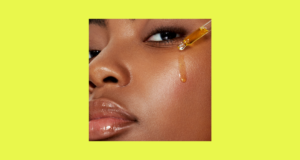I’m gonna bet that your current conditioning routine involves haphazardly raking a blob of conditioner through your curls, letting it sit for a few minutes (jk, like 60 seconds max), rinsing it out, and calling it a day. Hey, that used to be my M.O. too. And then I stumbled upon the very magical, very excellent “squish to condish” (or S2C), a hair-conditioning method that helps push even more moisture into your curls to keep them hydrated and healthy even after you rinse. And as anyone with curly hair knows, moisture = life.
Squish to condish, which was originally created by hairstylist and curl expert Melissa Stites, is now one of the most popular curl-conditioning methods you’ll find on the interwebs (like, try to spend a few minutes on Reddit’s r/curlyhair community without seeing it mentioned). And the hype, IMO, is deserved: For the majority of curl types (my thin, fine curly hair included), squish to condish really does boost moisture levels, encourage curl formation, and cut down on frizz and flyaways—as long as you know how to do it properly.
And that’s where I come in. I’m breaking down the best squish to condish tutorials and products to help you test out the s2c technique without getting lost in information overload. Keep reading and get ready for some really, really good hair (after some trial and error—you know the drill). But first…
The squish to condish method is a conditioning technique that helps push water into the cuticles of your hair so they get (and stay) properly moisturized. When you just rake a palmful of conditioner through your wet hair and rinse it out—i.e., your usual way of doing it—the conditioner isn’t really getting underneath your hair cuticle; it’s mostly just sitting on top before getting rinsed down the drain.
Squish to condish, however, uses manipulation—like squishing and scrunching—to slightly raise those hair cuticles and force water and conditioner into them. Think of it like misting a plant vs. fully watering it. Or like thoroughly mixing a batter until every ingredient is fully incorporated and dissolved.
As with all curly-hair products, routines, tips, and hacks, your results may vary. BUT, speaking as someone who tried squish to condishing and noticed happier, less straw-like curls after only three weeks of consistent s2c, I’m definitely on the side of “yup.”
In fact, if you want some visual “proof” as to how squish to condish works in comparison to your regular conditioning, check out these microscopic hair photos from the Science-y Hair Blog (a very wonderful fact-based blog that’s super popular in the curly hair world). The photos show the difference between a regularly conditioned hair strand (where the cuticle looks poorly coated and patchy), vs. a squish to condish hair strand (where the cuticle looks evenly coated and saturated with water and conditioner). Overall, way better.
The idea behind squish to condishing your curly hair is pretty simple: flip your head over, load up your wet hair with conditioner, then squish in palmfuls of water to slowly rinse it out. But lemme break it down for you:
Oh, you’re saying words aren’t super helpful and you need some video tutorials? Yeah, yeah—I get it. So here are a few of my favorite squish to condish how-to videos.
Every curl type can try the squish to condish method, but if your hair is super prone to tangles or fairy knots, or you’re dealing with major breakage and damage right now, squish to condish can potentially cause more knots through squishing. Why? Because when your hair is high-porosity or damaged—think: color-treated or chemically treated—your hair cuticle is already raised and open (healthy cuticles should lay flat and smooth; raised cuticles can tangle and break). That’s not to say you can’t try squish to condish, but just be aware of the potential for your hair to tangle or knot even more.
Think of squish to condish as just another took in your curly-hair tool belt. Try it out for a few weeks (really, I’m a firm believer in trying out a curl method at least six times before you decide it’s not for you) and see how your hair does. Not a fan the first few times? Try switching up conditioners (formulas matter!) and see how you do. And lucky for you, there’s basically an infinite number of curl tricks in existence, so if this one doesn’t work, there’s always another one.











